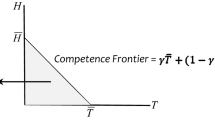Abstract
Previous research in the areas of tournaments, human capital, and learning theory have shown that promotion is a function of human capital, experience, ability, and wage growth. These variables were used to estimate a Cox regression using data from a single firm. The survival rates for a Cox regression and an up-or-out regression model are computed. The results suggest that certain up-or-out models are valid even when the firm does not have such a policy and show that an up-or-out procedure predicts the promotion and exit survival rates as well as a Cox regression.
Similar content being viewed by others
References
Baker, George, Michael Gibbs, and Bengt Holmstrom. 1994a. “The Internal Economics of the Firm: Evidence from Personnel Data.”Quarterly Journal of Economics: 881–919.
Baker, George, Michael Gibbs, and Bengt Holmstrom. 1994b. “The Wage Policy of a Firm.”Quarterly Journal of Economics: 922–955.
Becker, Gary S. 1962. “Investment in Human Capital: A Theoretical Analysis.”Journal of Political Economy 70: 9–49.
Bernhardt, Dan 1995. “Strategic Promotion and compensation.”Review of Economic Studies 62: 315–339.
Bhattacharya, Sudipto, and J. Luis Guasch. 1988. “Heterogeneity, Tournaments, and Hierarchies.”Journal of Political Economy 96: 867–881.
Bowman, Willam R., and Stephen L. Mehay. 2002. “College Quality and Employee Job Performance: Evidence from Naval Officers.”Industrial and Labor Relations Review 55: 700–714.
Chan, William. 1996. “External Recruitment versus Internal Promotion.”Journal of Labor Economics 14: 555–570.
Farber, Henry S., and Robert Gibbons. 1996. “Learning and Wage Dynamics.”Quarterly Journal of Economics: 1007–1047.
Gibbons, Robert, and Michael Waldman. 1999. “Careers in Organizations: Theory and Evidence.”Handbook of Labor Economics, Vol. 3. Elsevier Science.
Gibbs, Michael. 1995. “Incentive Compensation in a Corporate Hierarchy.”Journal of Accounting and Economics 19: 247–277.
Hamilton, Barton, and Mary MacKinnon. 2001. “An Empirical Analysis of Career Dynamics and Internal Labor Markets during the Great Depression.” Working paper.
Harrigan, Margaret N. 1999. “An Analysis of Faculty Turnover at the University of Wisconsin-Madison.”39th Annual AIR Forum.
Harris, Milton, and Bengt Holmstrom. 1992. “A Theory of Wage Dynamics.”Review of Economic Studies 49: 315–333.
Hashimoto, Masanori. 1981. “Firm-Specific Human Capital as a Shared Investment.”American Economic Review 71: 475–482.
Kahn, Charles, and Gur Huberman. 1988. “Two-Sided Uncertainty and ‘Up-or-Out’ Contracts.”Journal of Labor Economics 6: 423–444.
Lazear, Edward P. 1998.Personnel Economics for Managers. New York: Wiley & Sons.
Lazear, Edward P. 1976. “Age, Experience, and Wage Growth”American Economic Review: 548–558.
Lee, T. 1992.Statistical Methods for Survival Data Analysis. New York: John Wiley.
Mosler, Karl, and Thomas Philipson. 1999. “Specification Analysis in Mixed Hazard Models and a Test of Crossing Survival Functions.”Statistical Papers 40: 37–54.
Murphy, Kevin J. 1986. “Incentives, Learning, and Compensation: A Theoretical and Empirical Investigation of Managerial Labor Contracts.”Rand Journal of Economics 17: 59–76.
O'Flaherty, Brendan, and Aloysius Siow. 1992. “On the Job Screening, Up or Out rules, and Firm Growth.”Canadian Journal of Economics 25: 346–368.
O'Flaherty, Brendan, and Aloysius Siow. 1995. “Up-or-Out Rules in the Market for Lawyers.”Journal of Labor Economics 13: 709–735.
Pendakur, Ravi, Fernando Mata, Stan Lee, and Natalee Dole. 2000. “Job Mobility and Promotion in the Federal Public Service.” Strategic Research and Analysis Directorate, Department of Canadian Heritage.
Rajan, Raghuram G., and Luigi Zingales. 2001. “The Firm as a Dedicated Hierarchy: A Theory of the Origins and Growth of Firms.”Quarterly Journal of Economics 116: 805–851.
Scoones, David, and Dan Bernhardt. 1998. “Promotion, Turnover, and Discretionary Human Capital Acquisition.”Journal of Labor Economics 16: 122–141.
Spurr, Stephen J., and William Barber. 1994. “The Effect of Performance on a Worker's Career: Evidence from Minor League Baseball.”Industrial and Labor Relations Review 47: 692–708.
Stern, Steven. 1994. “Ability, Promotion, and Optimal Retirement.”Journal of Labor Economics 12: 119–137.
Waldman, Michael. 1990. “Up-or-Out Contracts: A Signaling Perspective.”Journal of Labor Economics 8: 230–250.
Author information
Authors and Affiliations
Corresponding author
Rights and permissions
About this article
Cite this article
Walker, R.L. Empirical analysis of up-or-out rules for promotion policies. J Econ Finan 29, 172–186 (2005). https://doi.org/10.1007/BF02761552
Issue Date:
DOI: https://doi.org/10.1007/BF02761552




